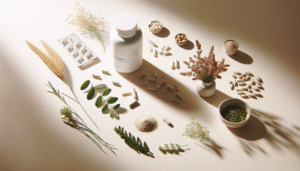Vitamin D does more than support bones as it plays a key role in hormone health, immune function, and your overall energy. For women over 30, getting enough vitamin D is one of the smartest wellness moves you can make.
Why Vitamin D Matters More After 30
Your body’s ability to make and absorb vitamin D starts to decline as you age. Combine that with busy indoor lifestyles, sunscreen use, and less time outside—and it’s no wonder deficiency is so common among women in their 30s, 40s, and beyond.
Vitamin D is fat-soluble, meaning your body stores it in tissue and uses it gradually. But too little over time can quietly sabotage your energy, mood, immunity, and even hormone balance.
Benefits of Vitamin D for Women Over 30
Vitamin D’s role in the body goes far beyond bone strength. It’s deeply involved in how women feel and function every day. Some of its benefits include:
1. Bone Strength and Longevity
Vitamin D helps your body absorb calcium, which is essential for strong bones. After 30, bone mass starts to decline slowly—especially in perimenopause and postmenopause. Supporting bone health now helps prevent osteoporosis later.
2. Mood Regulation & Hormone Health
Low vitamin D has been linked to increased risk of depression, anxiety, and PMS symptoms. It also influences estrogen, cortisol, and thyroid function—key hormones for mood, metabolism, and cycle regularity.
3. Immune Support
Vitamin D plays a protective role in your immune system. It helps regulate inflammatory responses and is being studied for its potential to reduce the risk of respiratory infections and autoimmune conditions.
4. Muscle Function & Energy
Fatigue, muscle aches, and low stamina are all common signs of low vitamin D. Maintaining optimal levels can support your mitochondrial health—the engines behind cellular energy.
How to Know If You’re Deficient
Vitamin D deficiency can be subtle. Signs may include:
- Persistent fatigue or low mood
- Muscle weakness or cramps
- Bone pain or frequent fractures
- Brain fog or low focus
- Frequent colds or infections
The best way to know? A simple blood test measuring 25-hydroxyvitamin D [25(OH)D]. Aim for levels between 30–60 ng/mL for optimal health, though some experts suggest 40–60 ng/mL for women.
How to Get More Vitamin D
Most women over 30 need a combination of sun, food, and supplementation to meet their vitamin D needs. Because lifestyle, skin tone, and location can affect your levels, knowing your options helps ensure consistent intake.
Sunshine
Just 10–30 minutes of midday sun exposure a few times a week can help your skin produce vitamin D—especially if you expose arms, legs, or back without sunscreen. But this varies by skin tone, location, and season.
Food Sources
While limited, these foods naturally contain vitamin D:
- Fatty fish like salmon, mackerel, sardines
- Egg yolks
- Liver
- Fortified foods (like dairy, cereals, or plant milks)
Supplements
Supplements are often necessary, especially in winter or if you live in northern regions.
- Choose vitamin D3 (cholecalciferol), not D2
- For better absorption, pair with K2 (MK-7 form)
- Typical maintenance doses: 1000–2000 IU daily, or higher if deficient (under medical guidance)
Testing & Supplementing Tips
- Test at least once a year—ideally in late winter when levels are lowest
- Work with your healthcare provider to adjust dosage based on results
- Vitamin D is best absorbed with food containing fat
- Track your intake using apps or wellness journals
Related Reading
Want to learn more about essential nutrients for your age? Check out our full guide: Top 5 Vitamins Women Over 30 Should Track
FAQ: Vitamin D for Women Over 30
How much vitamin D should I take daily?
Most women over 30 do well with 1000–2000 IU/day, but testing is key to determine your exact needs. Some may need 4000 IU/day or more short-term if deficient.
Can I get enough vitamin D from food alone?
It’s very difficult. Even fortified foods and fatty fish provide only small amounts. Supplementation is often necessary.
What time of year are vitamin D levels lowest?
Late winter and early spring, especially in areas with less sunlight. This is when testing is most informative.
Does sunscreen block vitamin D production?
Yes, it can. Sunscreen with SPF 30+ may reduce vitamin D synthesis by 95% or more. You don’t need to skip sunscreen, but brief, unprotected exposure can help.
Can low vitamin D affect menstrual cycles or fertility?
Yes. Vitamin D plays a role in hormone regulation, including estrogen and progesterone balance. Low levels may influence PMS, cycle regularity, and ovulation.
Is vitamin D safe during perimenopause or menopause?
Absolutely. It becomes even more important for bone health and mood support during hormonal transitions.
A Word From Vitamins For Woman
You deserve to feel vibrant, strong, and clear-headed at every stage of womanhood. Vitamin D might be a small nutrient, but its impact is massive—especially for women navigating their 30s and beyond.
Testing, supplementing wisely, and tuning into your body’s needs can set you up for more energy, better mood, and lifelong resilience. You’re worth that kind of care.
References
- Holick, M. F. (2007). Vitamin D deficiency. New England Journal of Medicine, 357(3), 266-281. https://doi.org/10.1056/NEJMra070553
- Cashman, K. D., et al. (2016). Vitamin D deficiency in Europe: pandemic? American Journal of Clinical Nutrition, 103(4), 1033–1044. https://doi.org/10.3945/ajcn.115.120873
- Schleicher, R. L., et al. (2016). Serum vitamin D status of the US population: 2011–2014. American Journal of Clinical Nutrition, 104(3), 454-461. https://doi.org/10.3945/ajcn.115.121962
- Di Rosa, M., et al. (2011). Vitamin D3: A helpful immuno-modulator. Immunology Letters, 134(2), 79–85. https://doi.org/10.1016/j.imlet.2010.09.007
- Penckofer, S., et al. (2010). Vitamin D and depression in women: A mini-review. Archives of Psychiatric Nursing, 24(6), 516–521. https://doi.org/10.1016/j.apnu.2010.03.011







